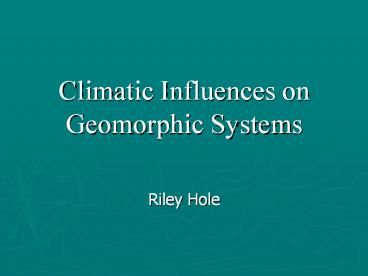Climatic Influences on Geomorphic Systems PowerPoint PPT Presentation
1 / 18
Title: Climatic Influences on Geomorphic Systems
1
Climatic Influences on Geomorphic Systems
- Riley Hole
2
Topics
- Definitions
- Historic Figures
- Areas of Study
- What Climate Does
- Climatic Regions
- Climate Change
- Problems
- Modern Day Approach
3
Definitions
Climate- the average weather of a region over
an extended period of time. Geomorphic
System- emphasizes the intimate
relationship between process and form
4
Contributing Figures
- William Morris Davis
- Davis Erosion cycle
- Different climates produce different processes
which in turn produce landforms - Know referred to as climatic geomorphology
- Von Richthofen
- Gave equal importance to the climate factors and
geological factors in - geomorphic processes.
- Thornthwait Koppen
- Regarded plants as meteorlogical instruments
which can be used to separate - climatic zones
- Albrecht Penck
- There are three types of climatic regions nival,
humid, and arid.
5
- Approach's taken by geomorphologists
- -Relationship between landforms and climate
- - Historical study and application of
landforms - - Study between process and form
- Areas most studied by geomorphologists
- -Arid environments
- -Polar regions
- WHY?
- Both arid and polar regions leave the landforms
bare - almost absent of vegetation
- Plus the presence of human activity is
drastically - reduced
6
Climatic Zones
Koppen System of climatic zone classification is
very complex It is divided into ten or so major
climate types and more than twenty subtypes All
these types can be combined to form numerous
combinations of very detailed climatic zone
areas Examples Ice Cap climate - EF Tropical wet
and dry or savanna - AW Desert - BW Dry-summer
subtropical CSA Maritime Temperate climates -
CFB Us here in Brandon, Manitoba experience a
Warm summer continental - Dfb
7
(No Transcript)
8
Climate at work
- Climate creates precipitation, heat transfer, and
winds of an area - These factors induce such effects as surface
moisture, vegetation, and weather - Climatic factors largely determine the nature and
effectiveness of the various processes of
weathering, transportation, and erosion - Climatic differences cause changes in the nature
and balance of the processes working on earths
surface - If climate in an area undergoes change different
assemblages of landforms will be produced
9
Effects of Climate in
Alpine Climate The climate in an alpine area
allows for a process called freeze thaw
weathering, this effect on the geomorphology is
only pronounced when the climate is expressed in
a particular way. Desert Climate The main
climatic factors that effect the geomorphology of
the desert area are wind, infrequent torrential
rains, and the over heating of rocks. Formation
of- Gours - Rock Deserts -
Yardangs Temperate Climate Artic climatic
regions help us to understand certain aspects of
the temperate Regions which have under gone
glacial periods during the Quaternary.
10
Facies and Climate Warm humid facies- Chemical
rock decomposition, gentle slopes, and rock
outcrops are rare Humid temperate facies-
Chemical rock decomposition, increase in the
steepness of slopes Dry
climate facies- Mechanical rock decomposition,
coarse soil fragments, rock escarpments are
present, stream flow becomes irregular, and
slope gradient increases yet Desert facies- The
clearest of the facies and mechanical weathering
acts alone. Cold dry facies- Slightly snow
covered deserts that experience little weathering
other than freeze thaw. Cold humid
facies- Glacial features occur in this area
11
Vegetative Zones
- One of the largest effects climate has on
geomorphic systems is the type of vegetation that
occupies an area - -Desert
- -Grassland
- -Rainforest
- The role of plant cover on fluvial erosion
- -Rate
12
Vegetation in
- Tropical Climate- Vegetation helps minimize
erosion during torrential rains - Temperate Climate- Rich soils can be developed
- - Trees, shrubs, and grasses slow the
rate of fluvial erosion - Desert Climate- Little to know vegetation is
present, prevailing winds are to move
sand in the form of dunes - Alpine Climate- large trees aid in the
decomposition of rock facies - Tundra Climates- contributes very little to soil
formation - -Protects what little soil there is
against the wind
13
(No Transcript)
14
Climate Change
- Glaciation
- -Ice ages have occurred at 200-250 million year
- intervals
- -Each of these intervals has lasted approximately
- 10 million years
- -Cold climate has cycled periodically every
- 100000 years within the 10 million year intervals
15
- Glaciers have a major effect on the formation
- of a landscape.
- Manitoban Topography
- -Eskers
- -Morains
- -Floodway Channels
- -Dunes
16
Problems
- A major problem with studying climatic
geomorphology is that climatic data does not span
much more than a century - Geomorphic events may take up to hundreds of
thousands of years to form - As a result climate data may only reflect recent
climatic conditions and effects - Human presence of an area greatly tampers with
historical evidence and also current happenings
17
Modern day approach
- Geomorphic environments require much more than
- just a climate
- Climatic geomorphology is considered the
- philosophical approach to study of geomorphology
18
- The End

